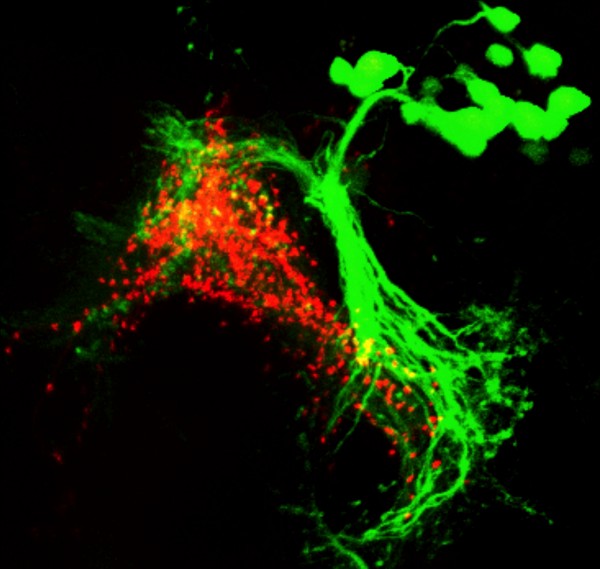Researchers Track the Neural Circuits Driving a Fly’s Choice of a Mate

Laboratory of Neurophysiology and Behavior/The Rockefeller University Recent research explains how the brain of a Drosophila male integrates taste and smell signals as he assesses potential mating partners. This image shows the convergence of two groups of nerve cells, one responding to a smell pheromone (green) and the other carrying taste-pheromone signals (red).
Now, a team of Rockefeller University researchers has explored in detail how the wiring of the male fly brain enables him to assess the suitability of a potential partner and instinctively decide whether to pursue or abandon her. In a recent study, they traced the neural circuits that convey signals from a fly’s sense organs into higher brain areas and make him able to integrate different features of a potential partner. The research, published in Neuron on August 13, offers new glimpses into the biological basis of decision making.
Before an ardent male Drosophila starts courting a female, he taps her with his front leg. “This allows him to taste the pheromones she carries on her waxy cuticle and thereby tell whether she’s appropriate and likely to be receptive to his courtship advances,” explains senior author Vanessa Ruta, Gabrielle H. Reem and Herbert J. Kayden Assistant Professor and head of the Laboratory of Neurophysiology and Behavior.
If the female passes the test, the male starts trotting after her with one wing off to his side, and by vibrating the wing he sings her a courtship song. Soon after — if the object of his serenade allows it — he mounts her to couple.
Earlier research has shown that a type of brain cell called a P1 neuron plays an important role in the male fly’s courtship decision. Until now, however, scientists knew little about how this cell population receives different types of sensory information and integrates it to produce a behavioral switch.
In their current study, the researchers show that P1 neurons receive input from at least three other nerve cell groups that transmit different — and sometimes contradictory — inputs. On the one hand, if the male tastes certain pheromones on the female, his arousal is triggered. On the other hand, he may simultaneously receive off-putting odor or taste signals from the female if she has mated before or belongs to a different species (or even if it turns out that the alleged female in fact is a male, which can happen).
“The beautiful thing about this system is that P1 neurons integrate all this different information, both taste and smell,” Ruta says. “Some information is exciting, some is suppressing, and his brain can combine it to form a behavioral choice.”
In one set of experiments, the researchers introduced male Drosophila to different potential partners, and monitored the activation of their P1 neurons under the microscope. “We brought in appropriate females as well as ones that had mated before, other males, and females of different Drosophila subspecies,” says postdoctoral fellow Josie Clowney, the study’s first author. “He will only court virgin females of his own species, and it’s very clear just from looking at the activity of the P1 neurons that he can tell who to mate with by both tasting and smelling the other fly.”
The researchers observed that the P1 neurons get activated only when the male tastes and smells a female that carry the correct pheromones. They then mapped the neural pathways that bring taste and smell signals into the fly’s brain, and found that these circuits come together and are integrated by P1 neurons themselves.
Ruta notes that research into Drosophila courtship behavior can provide important clues about how the human brain functions. “Though the Drosophila brain is a lot simpler than ours, there are basic similarities,” she says. “We are constantly making decisions after evaluating and weighing different sensory signals in the environment, some of them conflicting. The sign at a crosswalk on the corner says ‘walk’ but we see a cab barreling through—do we proceed or do we stay?
“By peering into the workings of the simpler fly brain,” Ruta adds, “we hope to better understand the basic architecture of neural circuits that integrate and assess different sensory information.”
Contact Information
Wynne Parry
Science Writer
wparry@rockefeller.edu
Phone: 212-327-7789
Media Contact
More Information:
http://www.rockefeller.eduAll latest news from the category: Life Sciences and Chemistry
Articles and reports from the Life Sciences and chemistry area deal with applied and basic research into modern biology, chemistry and human medicine.
Valuable information can be found on a range of life sciences fields including bacteriology, biochemistry, bionics, bioinformatics, biophysics, biotechnology, genetics, geobotany, human biology, marine biology, microbiology, molecular biology, cellular biology, zoology, bioinorganic chemistry, microchemistry and environmental chemistry.
Newest articles

High-energy-density aqueous battery based on halogen multi-electron transfer
Traditional non-aqueous lithium-ion batteries have a high energy density, but their safety is compromised due to the flammable organic electrolytes they utilize. Aqueous batteries use water as the solvent for…

First-ever combined heart pump and pig kidney transplant
…gives new hope to patient with terminal illness. Surgeons at NYU Langone Health performed the first-ever combined mechanical heart pump and gene-edited pig kidney transplant surgery in a 54-year-old woman…

Biophysics: Testing how well biomarkers work
LMU researchers have developed a method to determine how reliably target proteins can be labeled using super-resolution fluorescence microscopy. Modern microscopy techniques make it possible to examine the inner workings…





















